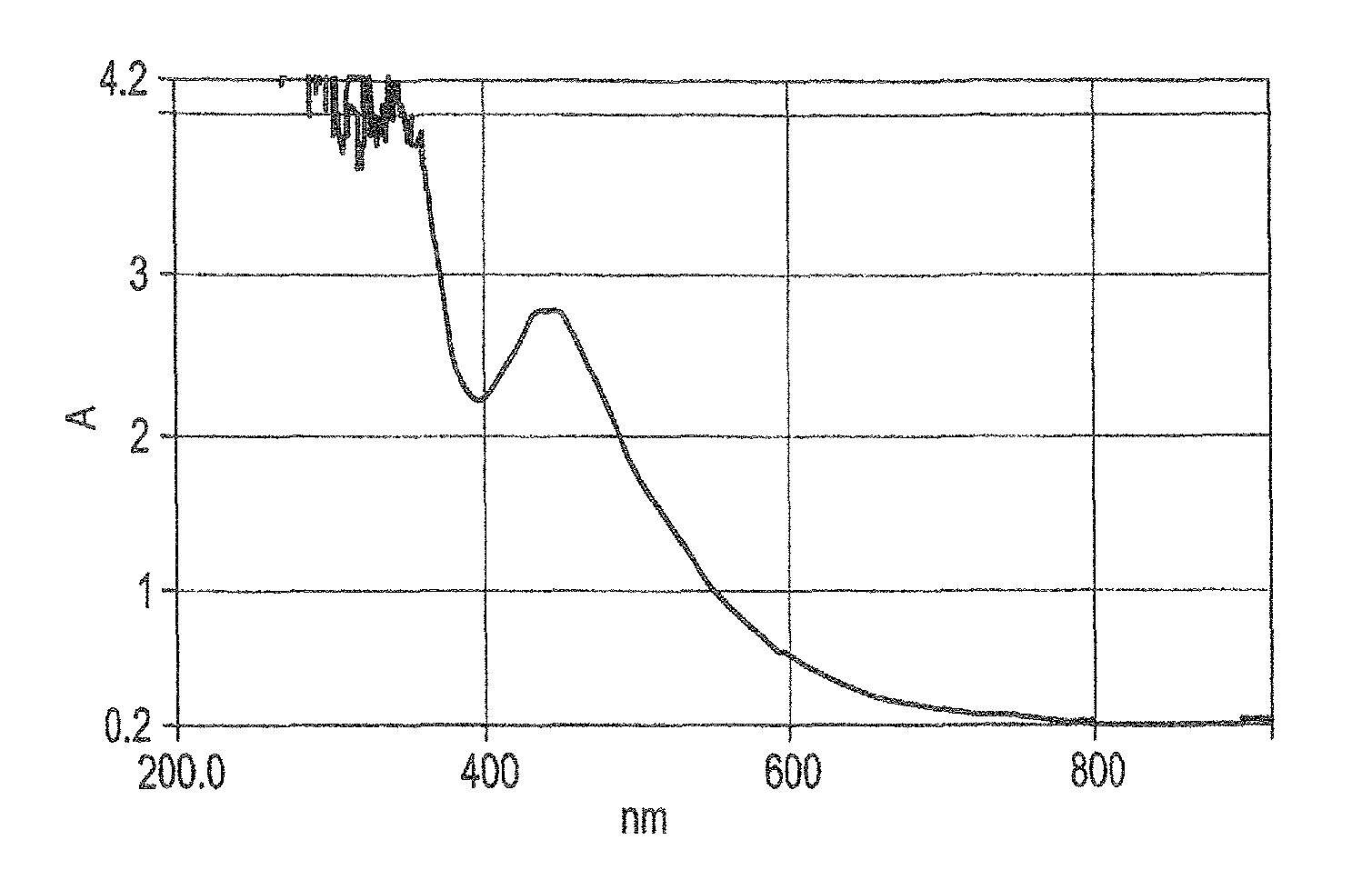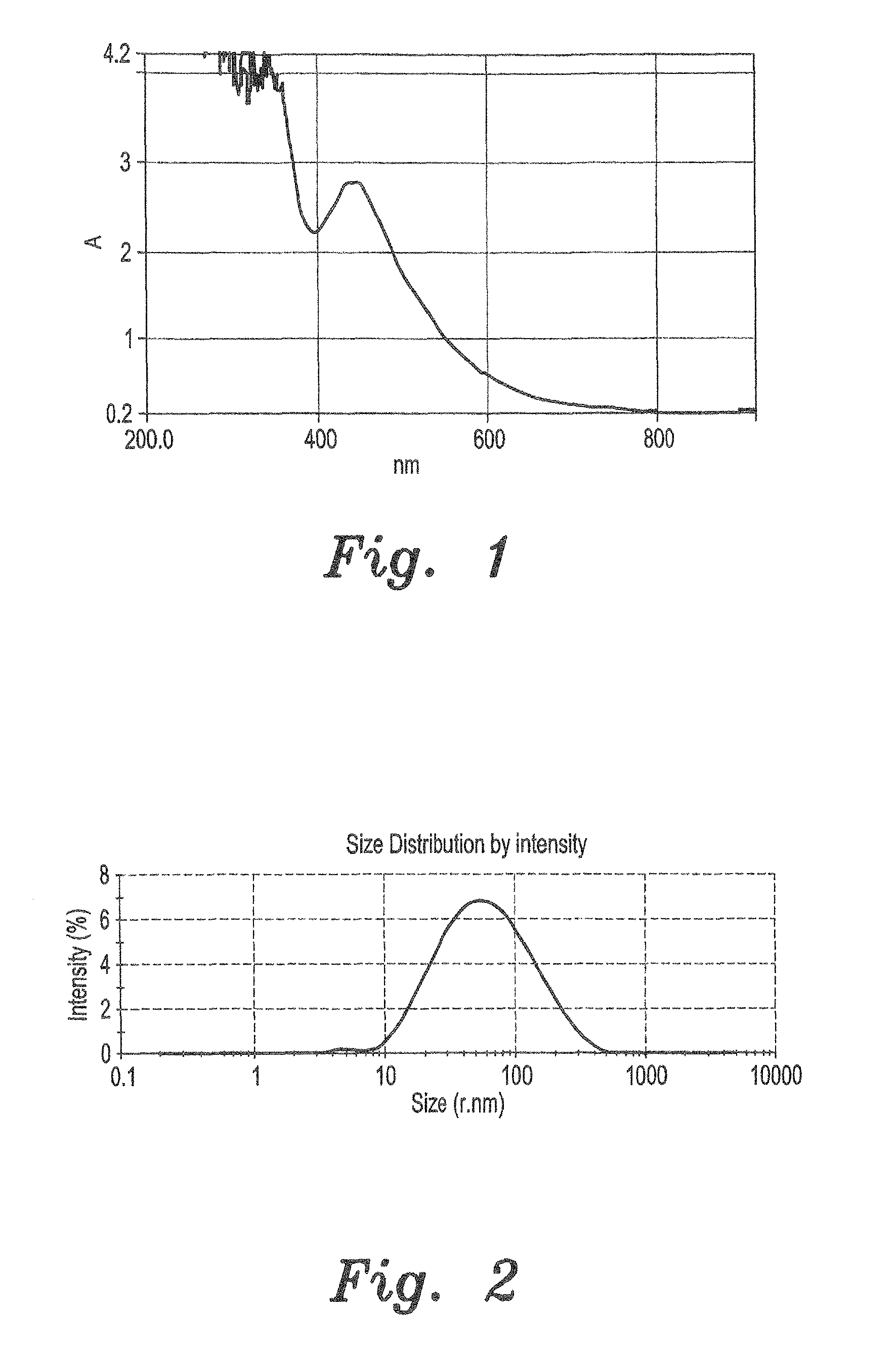Synthesis of nanoparticles of metals and metal oxides using plant seed extract
a technology of metal oxides and nanoparticles, applied in the field of nanobiotechnology, can solve the problems of chemical species adsorption on the surface that may have adverse effects on medical applications, non-ecofriendly byproducts, and metal nanoparticles have received attention, so as to inhibit the growth of bacteria, inhibit and reduce the concentration of contaminan
- Summary
- Abstract
- Description
- Claims
- Application Information
AI Technical Summary
Benefits of technology
Problems solved by technology
Method used
Image
Examples
example 1
Green Synthesis of Silver (Ag) Nanoparticles
[0027]Silver nanoparticles were prepared according to the following method. About 15 mg of the seeds of the plant (Trigonella foenum-graecum) was soaked in about 30 ml of distilled water overnight, then filtered, and the aqueous extract was set aside until used. About 5 ml of the extract was added to about 50 ml of an aqueous solution of 0.001 mole / L silver nitrate (AgNO3) and stirred for about 15 minutes at 45° C. Reduction of the silver ions by the seeds extract of Trigonella foenum-graecum resulted in the formation of silver nanoparticles. This reduction process was monitored by the change of color from colorless to dark brown. FIG. 1 shows the absorption peak of the silver nanoparticles solution corresponding to the surface plasmon resonance (SPR) obtained in a visible range at 439.29 nm by UV-Vis spectroscopy. FIG. 2 shows the particle size distribution by intensity obtained using a Zeta sizer, showing the average silver nanoparticle ...
example 2
Treatment of Sewage Water by Silver Nanoparticles Synthesized by (Trigonella foenum-graecum) Seeds Extract
[0028]About 5 ml of silver nanoparticles synthesized as described in Example 1 was added to a bottle, which contains 3 Liters of typical sewage water. Then the bottle was kept aside for 2 or 3 days, after which time the treated water was filtered. Table 1 shows the results of the concentration of chemicals treated with the silver (Ag) nanoparticles.
[0029]
TABLE 1Chemical characteristics of water treated with silver nanoparticlesEC*SO42−Cl−HCO3−Mg2+Ca2+SamplepH(ppm)(ppm)(ppm)(ppm)(ppm)(ppm)Normal water7.93697.648.376.164.129.682.6Sewage Water8.671267.2167.6553.857.181.1136.1Sewage water7.28723.247.2182.166.347.6104.5treated by Silvernanoparticles*EC = Electrical Conductivity
example 3
Antibacterial Activity of the Silver Nanoparticles
[0030]A pure culture of Escherichia coli bacteria was used for assessing the antibacterial activity of the silver nanoparticles synthesized as described in Example 1. The antibacterial activities of the nanoparticles were carried out by a disc diffusion method. Nutrient agar medium plates were prepared, sterilized and solidified. After solidification bacterial cultures were swabbed on these plates. The sterile discs were dipped in nanoparticles solution of 1, 5, 10 (μg / ml) and placed in the nutrient agar plate and kept for incubation at 370° C. for 24 hours. A zone of clearing around the wells was observed, indicating the inhibitory activity of silver nanoparticles.
PUM
| Property | Measurement | Unit |
|---|---|---|
| temperature | aaaaa | aaaaa |
| temperature | aaaaa | aaaaa |
| diameter | aaaaa | aaaaa |
Abstract
Description
Claims
Application Information
 Login to View More
Login to View More - R&D
- Intellectual Property
- Life Sciences
- Materials
- Tech Scout
- Unparalleled Data Quality
- Higher Quality Content
- 60% Fewer Hallucinations
Browse by: Latest US Patents, China's latest patents, Technical Efficacy Thesaurus, Application Domain, Technology Topic, Popular Technical Reports.
© 2025 PatSnap. All rights reserved.Legal|Privacy policy|Modern Slavery Act Transparency Statement|Sitemap|About US| Contact US: help@patsnap.com



